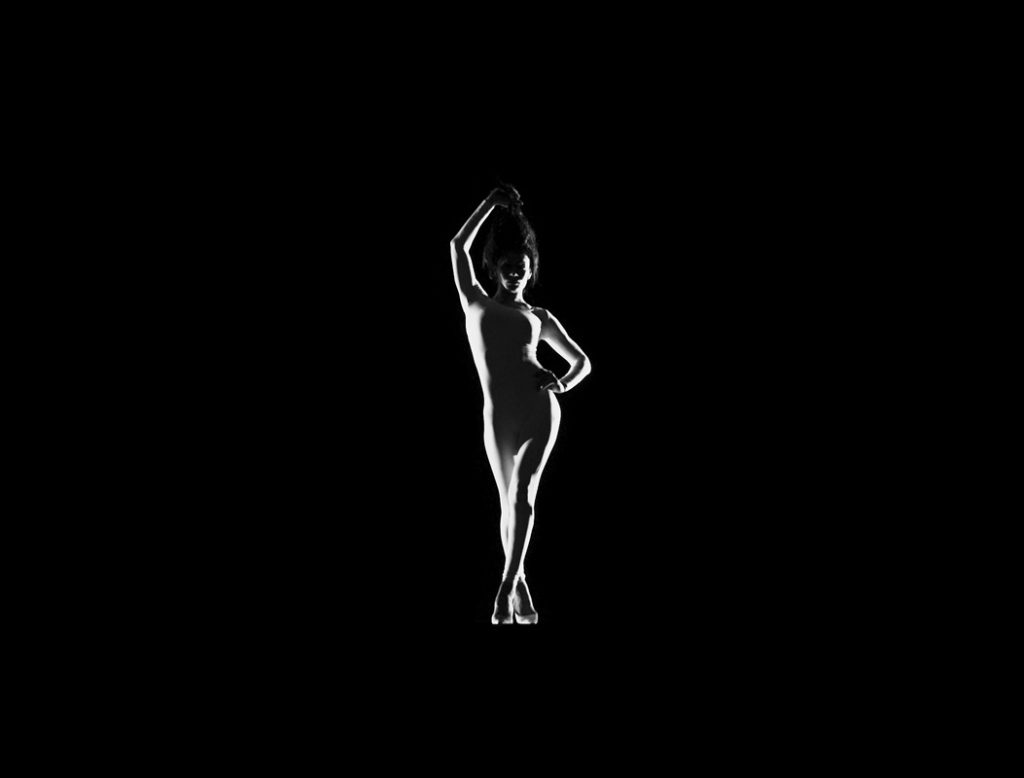Jeremy Shaw is an explorer discovering new worlds, but the Berlin-based Vancouver artist doesn’t travel to remote lands to dig for the relics of lost cultures or study vanishing tribes engaging in mystical rituals. He finds treasure everywhere he looks, whether it’s at a subculture of sex- and drug-free punk rockers, or the depths of his own mind while tripping on hallucinogens. His first solo exhibition of 2015, “Medium-Based Time” at the Contemporary Art Gallery, features two films, Variation FQ (2011–2013) and Quickeners (2014), both of which guide us on odysseys that eclipse and transcend the conventions and confines of everyday life.
Variation FQ showcases legendary voguer Leiomy Maldonado in a luminous white bodysuit against a black backdrop, doing signature vogue dance moves that push the limits of her body just short of reckless abandon. Shaw’s accompanying soundtrack combines chopped vocals and trance beats with a melancholy piano score that barely tempers the explosiveness of her movements, which become increasingly fluid and ethereal as the dance progresses. Shaw overlays step-and-repeat special effects that outline and duplicate the contours of her moving body, heightening the sense of metamorphosis. The dance culminates with a vogue move called a “death drop” for its body-contorting, gravity-defying qualities, and the ghostly special effects makes it appear as if she transforms from flesh and bone into liquid, becoming a cascading waterfall and, finally, a moonlit pool. It matters that Maldonado is transgender, in part because Shaw is fascinated with minorities, vortexes and altered states, and because she’s so right in her body. Variation FQ is an elegant celebration of transgender people, but it’s also a commemoration of transformation, a marker of the beginning of the end of binary-gender orthodoxy and a portal into a post-gender world.
Shaw’s most recent work, a 33-minute film called Quickeners (2014), is also about transcending biological constraints. Using footage from a 1967 documentary, Holy Ghost People, about a Pentecostal sect of snake handlers in rural West Virginia, Shaw overlays his own audio narrative to tell a story set 500 years after humanity experienced an “intelligence explosion” that transformed them into immortal “Quantum Humans”—logical, super-intelligent beings connected to “the Hive,” a neural interface with the capacity to “explain everything.” In this demystified posthuman world, all “speculative phenomena”—from religious worship to the making of art—are viewed as irrational “neural confabulations in the brain” that were largely abandoned at the dawn of posthumanity. It might seem counterintuitive to rely on black-and-white footage from a 1967 documentary to tell a story set in the distant future, but the pale, conservatively dressed Christians and the backdrop of drab, rural America are fitting surrogates for a techno-dystopian tale. Shaw’s choice of archival footage makes the recent past seem at once familiar, yet just as alien as the distant future.
We are introduced to a breakaway sect of posthumans that have developed “Human Atavism Syndrome,” a rare disorder in which they “need to believe.” The narrator tells us that these revival meetings involve outdated rituals that “violate all logic”—dancing, singing, shrieking, praying and the handling of poisonous snakes. We know snakes are coming, but, first, the preacher warms up the expectant crowd.
Through the narration and subject interviews, we learn that their pursuit of rapture is called “the Quickening,” a “pure cathartic transcendence” that also obscures Hive reception, like a computer glitch or ghost in the machine, which garbles their speech, necessitating subtitles. We also learn that Quickening occurs in certain posthumans: when a woman realizes she’s pregnant and when an immortal dies by beheading, a funny nod to the film Highlander and a deadly serious comment on techno-utopian totalitarianism and the paradox of extreme rationalism. The end goal for the Quickeners is the return to a mortal, human state and the “retrieval of the soul.” These are high stakes, even for mortal religious agnostics like me, so it’s no wonder that people denied singing and dancing for hundreds of years are self-conscious wallflowers. Much like Shaw’s earlier films—particularly Best Minds Part One, a video of celibate, straight-edge, male punk rockers doing a sort of no-slam dancing—the dramatic tension that accompanies the awkward process of letting go is beautifully paced, and makes the moment of liberation even more exhilarating.
The documentary footage of a snake-handling ceremony heightens the drama brilliantly. When the snakes are released, things get really trippy: the footage goes into slow motion, washes of blue and pink colour the revelers’ blurred faces and dubstep techno beats flood the senses. The trip out was so effectively drawn that my pulse was racing, my empathy neurons lit up and I felt untethered from the constraints of personal bias, logic and indifference. An interference in my hive reception occurred, like the one a Quickener described as “a memory of memory” and forgetting “while remembering even more.”
Outside the gallery, Shaw provided a send-off with Degenerative Imaging (In the Dark) (2015), a series of glow-in-the-dark vinyl prints sourced from 3-D scans of brains under the influence of street drugs. Displayed in the windows of the CAG, they look at once like the hockey masks of bogeymen, this-is-your-brain-on-drugs PSAs and the lonely, beaten-up face of the moon. Once again, Shaw proves that history is happening right now, and that mystical rituals can be found right here. In a week, or sooner, I’ll go back to that chapel for another dose.
This post was corrected on April 2, 2015. The original article erroneously referred, in the second paragraph, to the work Quickeners as The Quickening. We regret the error.









